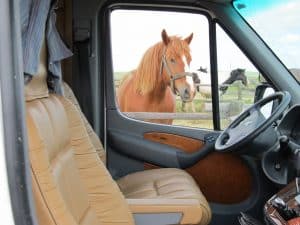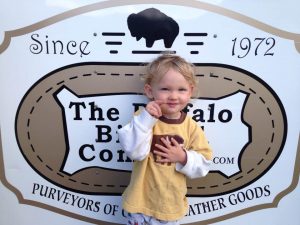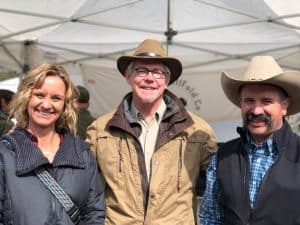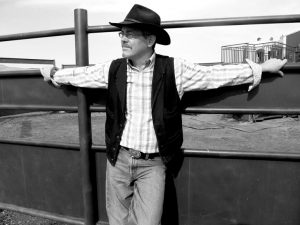The Last Round Up – 2019
The Cicada’s buzz and whir in the trees and air, The Ash trees are slowly turning yellow, the seagulls lazily circle in rafts above me as they wend their way southward. The occasional call from one of the birds can be heard on earth…… a thousand feet below.
At lower elevations the Monarchs do the same thing as they float on the air.
They perform and engage their intuitive, generational, migratorial instinct on their way to Mexico.
A generation or two later they will have arrived to repeat this sequence.
Their procreation will allow them to once again find Canada as a refuge and the amazing event continues.
Our fall Expeditionary Tour coincides with the Monarchs and Franklin Seagulls. We are all headed in a southerly direction. As they drift with the wind, we have predefined stops along the way, we haven’t their luxury.
Across the tall and short grass prairies of South Dakota we have a destination of Custer State Park, the largest State Park in the lower 48 states, perhaps the nation.
It is a time that my friend Chad Kremer (herd manager) rounds up all the buffalo (bison bison) in the state park.
His job entails rounding up hundreds/thousands of buffalo from every nook and cranny found in the topographic maize of the Black Hills landscape.
This event is the highlight of a years worth of travels. If it is dry it will be dusty, if it is wet, it will be muddy, if it is cold it might be sleet and snow.
It is the real life experience of a herdsman, a cowboy, a buffalo rancher.
The public has the opportunity to experience nature in a real environment, unmanaged or manipulated by comforts or convenience.
During this weekend the herd will be rounded up, corralled, branded, inoculated, culled, tagged, weighed and sent to their appropriate pasture in the wilds of Custer State Park.
Kremer looms larger than life as he performs his duties in front of tens of thousands of spectators and tourists.
His audience comes from all over the world, German, Italian, U.K. Japanese (and many others). The TV cameras from all of these nations whir as the buffalo are being corralled.
As they watch the herdsman rounding up the buffalo, they don’t often fully appreciate the complexity of the event.
The animals are big and dangerous and can nearly tip over a pick up truck if one set its mind to it.
The State of South Dakota and Custer State Park mindfully do much more than corral buffalo.
They have the trickier task of rounding up all of the errant tourists and keeping them corralled and safe as well.
Having some background in “event development” I find this “round up” quite intriguing and multi faceted.
With a herd of a thousand buffalo charging toward you, mistakes in crowd management could prove fatal and scar the event for years to come.
They have placed their faith in a man that is up for the task.
Custer State Park has done this for decades and has a very good track record of safety and tourist appreciation.
Wielding a branding iron and pleasing the often fickle public can be a fine needle to thread !
It should be noted that a century ago, Bison were on the brink of extinction.
Government Conservation and Game Laws brought them back from the brink.
It should also be noted that individual ranchers throughout the United States increased their numbers exponentially during the ensuing century.
Today, they are nowhere near “endangered” and are raised for the highest quality low fat meat.
The animal itself perfectly utilizes the western short grass prairie like no cow/cattle rancher could ever dream.
The meat is so sought after, they are raised by the herd and sold by the ounce.
It is a perfect fit that works well on the North American landscape.
———————-www.billkeitel.com
We work, we toil, we sort hides, twenty, forty thousand square feet of hides. we notice brands that indicated previous ownership of our tanned hides. The brands often reveal the friendships that we have made through the decades.
These are not just brands…These are forensic marking of animals and people we know. These are the ranchers that heated the branding irons and wet checked the females. We can see this recognizing the stretch marks on the hides that we have tanned.
If we had “corrected” the grain in our tanning process we would not have made these associations.
Correcting the grain would have covered up the scrapes, scars, wrinkles and brands, by putting on an embossed finish.
We actually spend more to tan the leather in this process that reveals the natural scars.
Our tanning process decreases our yield in production but enhances our pride of knowing the animal.
After 47 years as a leather smith my work and craftsmanship is still seems intimate.
I know the tanner and his employees, I know the broker of hides, I know the animal, I know whether it was raised in a feed lot or wsa free ranging and I know the rancher. Just by looking at the hide.
It is my craft, it is my trade and my profession.
I notice the seven and the thirteen numerals brand on the hide, I also know that this indicates that these bison came from Custer State Park. They brand the calf by the numeral of the current year.
It tells us the year that they were born and we extrapolate the age of the animal when it went to market.
We think of ourselves as the ultimate “re-purposers”.
We ensure none of this animal goes to waste and over the years we have spent hundreds of thousands of dollars tanning these hides for our very specific purposes. This includes texture, weight/thickness, crust and hand.
The tanning process is much like a recipe that your grand mother has handed down through the generations. We have taken her recipe and twisted, tweeked, and turned it inside out to perfect our leather.
It was an overnight success that took two or three decades of determination and experimentation.
Tonight we ease back in the saddle and reflect on our final ROUND UP of the season.
We’ve hurried ourselves in production, we’ve toiled over machinery and making sure it’s running properly.

The Expeditionary Tour heads off to Western South Dakota for the Round Up and then we turn the wagons southerly towards New Mexico.
We will spend two weeks on the Sandia Indian Reservation exhibiting at the Rio Grande Art Fiesta. It is held during the Albuquerque Balloon Festival, seven hundred to a thousand hot air balloons will fill every space in the heavens.
We will reconnect with other artists, artisans and craftsman at this festival. Many are Navajo, Hopi, Zuni, Apache, Northern Crow, Arapahoe, Bulgarian, German, Ho Chunk, Lakota, Ojibway and many varied ethnicities.
All of these people create a fabric of love and lifestyle, for we all live on the road.
We meet in Southwestern U.S. and in the far North of Fargo, North Dakota, from Milwaukee Indian Summer to Bozeman and Buffalo Wyoming.
We have shared babies “first steps”, we have shared music, we have shared flat tires, life and death. To us, they are kindred, they are our companions on the road. We all help create this metaphor.
For small craftsman and businessmen like ourselves, the expenses are large.
We trust that after the fuel expense, insurance, wages, hotels, electricity, booth fees, taxes, drayage fees, tires, batteries, lighting and food, there will be profit left over for us.

Bill and Lauri Keitel
Buffalo Billfold Company
See You Out On the Trail!

